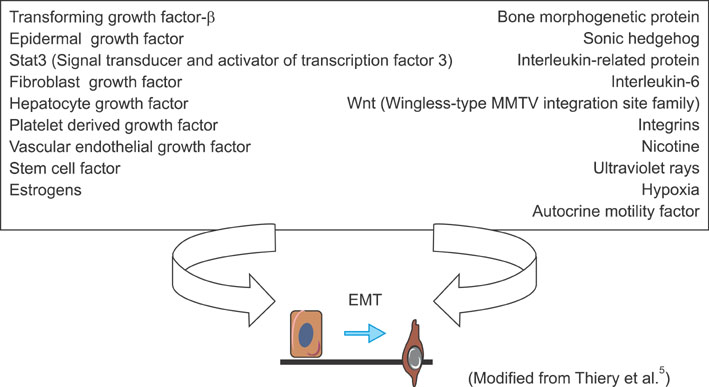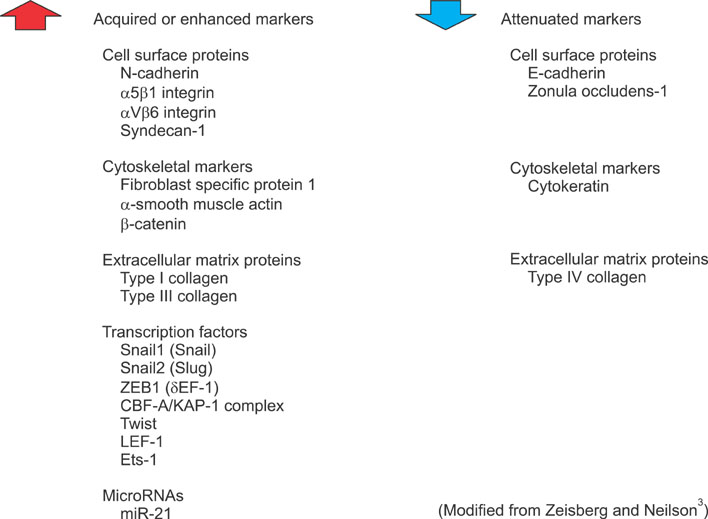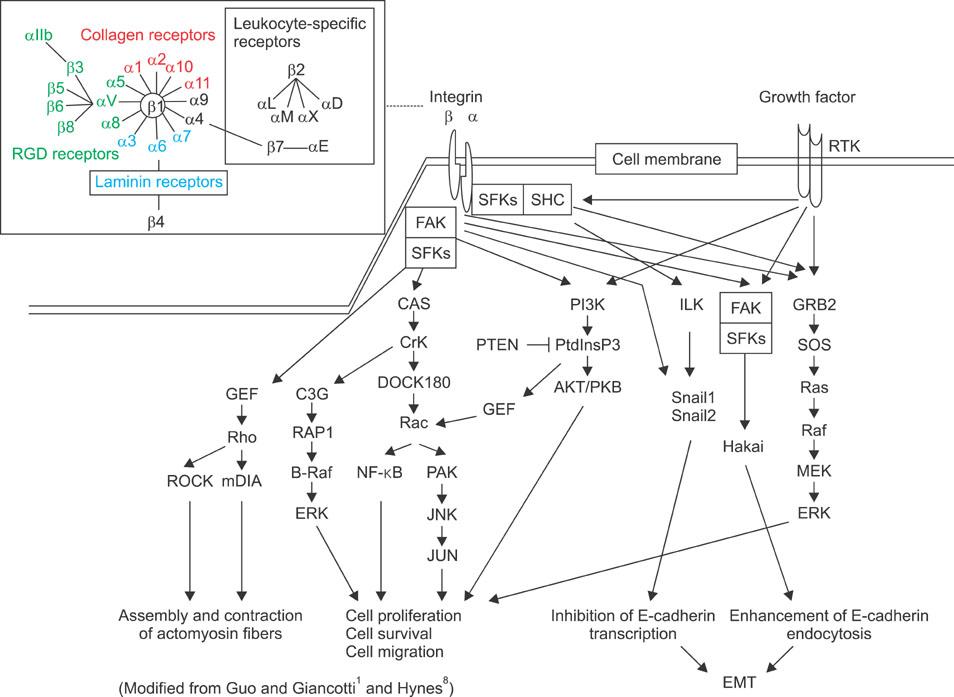Ann Dermatol.
2011 May;23(2):125-131. 10.5021/ad.2011.23.2.125.
Epithelial Tumor, Invasion and Stroma
- Affiliations
-
- 1Department of Dermatology and Research and Clinical Center for Yusho and Dioxin, Kyushu University, Fukuoka, Japan. furue@dermatol.med.kyushu-u.ac.jp
- KMID: 2156651
- DOI: http://doi.org/10.5021/ad.2011.23.2.125
Abstract
- Uncontrolled proliferation is a defining feature of the malignant phenotype. Nevertheless, the supportive network provided by the stroma is indispensable for further invasion, progression and metastasis of cancer cells. In addition, the role of inflammation in tumorigenesis is now generally accepted, and it has become evident that an inflammatory microenvironment is an essential component of tumor progression. Since skin tumors are common and easily assessable lesions with features at various stages of tumorigenesis, they provide a wide scope for research in this field to further our understanding of fundamental and clinical carcinogenesis. Some of the basic aspects of epithelial tumorigenesis, invasion and stromal reaction are reviewed in this paper.
Keyword
Figure
Reference
-
1. Guo W, Giancotti FG. Integrin signalling during tumour progression. Nat Rev Mol Cell Biol. 2004. 5:816–826.
Article2. Steeg PS. Tumor metastasis: mechanistic insights and clinical challenges. Nat Med. 2006. 12:895–904.
Article3. Zeisberg M, Neilson EG. Biomarkers for epithelial-mesenchymal transitions. J Clin Invest. 2009. 119:1429–1437.
Article4. Miyazono K. Transforming growth factor-beta signaling in epithelial-mesenchymal transition and progression of cancer. Proc Jpn Acad Ser B Phys Biol Sci. 2009. 85:314–323.
Article5. Thiery JP, Acloque H, Huang RY, Nieto MA. Epithelial-mesenchymal transitions in development and disease. Cell. 2009. 139:871–890.
Article6. Cano A, Pérez-Moreno MA, Rodrigo I, Locascio A, Blanco MJ, del Barrio MG, et al. The transcription factor snail controls epithelial-mesenchymal transitions by repressing E-cadherin expression. Nat Cell Biol. 2000. 2:76–83.
Article7. Perl AK, Wilgenbus P, Dahl U, Semb H, Christofori G. A causal role for E-cadherin in the transition from adenoma to carcinoma. Nature. 1998. 392:190–193.
Article8. Hynes RO. Integrins: bidirectional, allosteric signaling machines. Cell. 2002. 110:673–687.9. Gupta GP, Massagué J. Cancer metastasis: building a framework. Cell. 2006. 127:679–695.
Article10. Harris AL. Hypoxia--a key regulatory factor in tumour growth. Nat Rev Cancer. 2002. 2:38–47.11. Semenza GL. Targeting HIF-1 for cancer therapy. Nat Rev Cancer. 2003. 3:721–732.
Article12. Chi JT, Wang Z, Nuyten DS, Rodriguez EH, Schaner ME, Salim A, et al. Gene expression programs in response to hypoxia: cell type specificity and prognostic significance in human cancers. PLoS Med. 2006. 3:e47.
Article13. Lining X, Uchi H, Hayashida S, Tsuji G, Kido M, Nakahara T, et al. Expression of hypoxia-inducible factor-1alpha and hypoxia-inducible factor-2alpha with progression of keratinocytic neoplasms. J Dermatol Sci. 2009. 56:135–136.
Article14. Chen SY, Takeuchi S, Moroi Y, Hayashida S, Kido M, Chen SJ, et al. Overexpression of phosphorylated-ATF2 and STAT3 in cutaneous squamous cell carcinoma, Bowen's disease and basal cell carcinoma. J Dermatol Sci. 2008. 51:210–215.
Article15. Lin N, Moroi Y, Uchi H, Fukiwake N, Dainichi T, Takeuchi S, et al. Significance of the expression of phosphorylated-STAT3, -Akt, and -ERK1/2 in several tumors of the epidermis. J Dermatol Sci. 2007. 48:71–73.
Article16. Staller P, Sulitkova J, Lisztwan J, Moch H, Oakeley EJ, Krek W. Chemokine receptor CXCR4 downregulated by von Hippel-Lindau tumour suppressor pVHL. Nature. 2003. 425:307–311.
Article17. Lorusso G, Rüegg C. The tumor microenvironment and its contribution to tumor evolution toward metastasis. Histochem Cell Biol. 2008. 130:1091–1103.
Article18. Hanna E, Quick J, Libutti SK. The tumour microenvironment: a novel target for cancer therapy. Oral Dis. 2009. 15:8–17.
Article19. Steinman RM, Banchereau J. Taking dendritic cells into medicine. Nature. 2007. 449:419–426.
Article20. Mantovani A, Sica A. Macrophages, innate immunity and cancer: balance, tolerance, and diversity. Curr Opin Immunol. 2010. 22:231–237.
Article21. Friedl P, Wolf K. Tumour-cell invasion and migration: diversity and escape mechanisms. Nat Rev Cancer. 2003. 3:362–374.
Article22. Balkwill F. Chemokine biology in cancer. Semin Immunol. 2003. 15:49–55.
Article23. Mitra SK, Hanson DA, Schlaepfer DD. Focal adhesion kinase: in command and control of cell motility. Nat Rev Mol Cell Biol. 2005. 6:56–68.
Article24. Birchmeier C, Birchmeier W, Gherardi E, Vande Woude GF. Met, metastasis, motility and more. Nat Rev Mol Cell Biol. 2003. 4:915–925.
Article25. Bhowmick NA, Neilson EG, Moses HL. Stromal fibroblasts in cancer initiation and progression. Nature. 2004. 432:332–337.
Article26. Spaeth EL, Dembinski JL, Sasser AK, Watson K, Klopp A, Hall B, et al. Mesenchymal stem cell transition to tumor-associated fibroblasts contributes to fibrovascular network expansion and tumor progression. PLoS One. 2009. 4:e4992.
Article27. Grivennikov SI, Greten FR, Karin M. Immunity, inflammation, and cancer. Cell. 2010. 140:883–899.
Article28. Eck SM, Côté AL, Winkelman WD, Brinckerhoff CE. CXCR4 and matrix metalloproteinase-1 are elevated in breast carcinoma-associated fibroblasts and in normal mammary fibroblasts exposed to factors secreted by breast cancer cells. Mol Cancer Res. 2009. 7:1033–1044.
Article29. Kleer CG, Bloushtain-Qimron N, Chen YH, Carrasco D, Hu M, Yao J, et al. Epithelial and stromal cathepsin K and CXCL14 expression in breast tumor progression. Clin Cancer Res. 2008. 14:5357–5367.
Article30. Drake FH, Dodds RA, James IE, Connor JR, Debouck C, Richardson S, et al. Cathepsin K, but not cathepsins B, L, or S, is abundantly expressed in human osteoclasts. J Biol Chem. 1996. 271:12511–12516.
Article31. Quintanilla-Dieck MJ, Codriansky K, Keady M, Bhawan J, Runger TM. Cathepsin K in melanoma invasion. J Invest Dermatol. 2008. 128:2281–2288.
Article32. Cordes C, Bartling B, Simm A, Afar D, Lautenschlager C, Hansen G, et al. Simultaneous expression of Cathepsins B and K in pulmonary adenocarcinomas and squamous cell carcinomas predicts poor recurrence-free and overall survival. Lung Cancer. 2009. 64:79–85.
Article33. Stimler-Gerard NP. Neutral endopeptidase-like enzyme controls the contractile activity of substance P in guinea pig lung. J Clin Invest. 1987. 79:1819–1825.
Article34. Albrecht M, Gillen S, Wilhelm B, Doroszewicz J, Aumüller G. Expression, localization and activity of neutral endopeptidase in cultured cells of benign prostatic hyperplasia and prostate cancer. J Urol. 2002. 168:336–342.
Article35. Kesse-Adu R, Shousha S. Myoepithelial markers are expressed in at least 29% of oestrogen receptor negative invasive breast carcinoma. Mod Pathol. 2004. 17:646–652.
Article36. Ogawa H, Iwaya K, Izumi M, Kuroda M, Serizawa H, Koyanagi Y, et al. Expression of CD10 by stromal cells during colorectal tumor development. Hum Pathol. 2002. 33:806–811.
Article37. Xie LN, Uchi H, Hayashida S, Kido M, Takeuchi S, Takahara M, et al. Stromal CD10 expression is correlated with invasiveness and proliferation of extramammary Paget disease. Br J Dermatol. 2008. 158:1389–1391.
Article38. Takahara M, Chen S, Kido M, Takeuchi S, Uchi H, Tu Y, et al. Stromal CD10 expression, as well as increased dermal macrophages and decreased Langerhans cells, are associated with malignant transformation of keratinocytes. J Cutan Pathol. 2009. 36:668–674.
Article39. Muangman P, Tamura RN, Muffley LA, Isik FF, Scott JR, Xie C, et al. Substance P enhances wound closure in nitric oxide synthase knockout mice. J Surg Res. 2009. 153:201–209.
Article40. Mantovani A, Allavena P, Sica A, Balkwill F. Cancer-related inflammation. Nature. 2008. 454:436–444.
Article41. Waldner MJ, Neurath MF. Colitis-associated cancer: the role of T cells in tumor development. Semin Immunopathol. 2009. 31:249–256.
Article42. Nickoloff BJ, Ben-Neriah Y, Pikarsky E. Inflammation and cancer: is the link as simple as we think? J Invest Dermatol. 2005. 124:x–xiv.
Article







